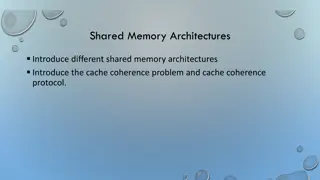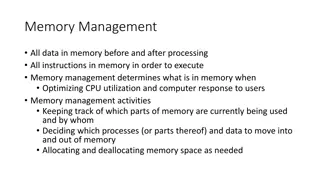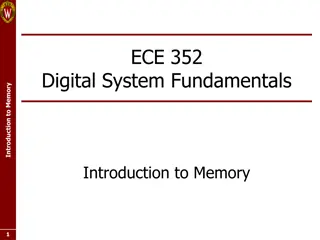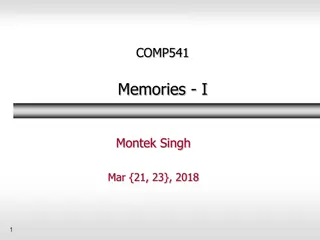in In-Memory Key-Value Storage
In-memory key-value stores play a crucial role in modern data storage systems, but face challenges with failures, latency, and redundancy. Erasure coding offers a solution by efficiently storing redundant information in memory for fast recovery. Learn about the benefits, challenges, and contributions of implementing erasure coding in high-availability in-memory KV stores.
Download Presentation

Please find below an Image/Link to download the presentation.
The content on the website is provided AS IS for your information and personal use only. It may not be sold, licensed, or shared on other websites without obtaining consent from the author.If you encounter any issues during the download, it is possible that the publisher has removed the file from their server.
You are allowed to download the files provided on this website for personal or commercial use, subject to the condition that they are used lawfully. All files are the property of their respective owners.
The content on the website is provided AS IS for your information and personal use only. It may not be sold, licensed, or shared on other websites without obtaining consent from the author.
E N D
Presentation Transcript
Erasure Coding for Small Objects in In-Memory Key-Value Storage Matt M. T. Yiu, Helen H. W. Chan, Patrick P. C. Lee The Chinese University of Hong Kong SYSTOR 2017 1
Introduction In-memory key-value (KV) stores are widely deployed for scalable, low-latency access Examples: Memcached, Redis, VoltDB, RAMCloud Failures are prevalent in distributed storage systems Replication in DRAM? High storage overheads Replication in secondary storage (e.g., HDDs)? High latency to replicas (especially for random I/Os) Erasure coding Minimum data redundancy Redundant information is stored entirely in memory for low-latency accesses fast recovery under stragglers and failures 2
Erasure Coding Divide data to kdata chunks Encode data chunks to additional n-k parity chunks Each collection of n data/parity chunks is called a stripe Distribute each stripe to n different nodes Many stripes are stored in large-scale systems Fault tolerance: any k out of n nodes can recover file data Redundancy: ? ? 3
Challenges Erasure coding is expensive in data updates and failure recovery Many solutions in the literature Real-life in-memory storage workloads are dominated by small-size objects Keys and values can be as small as few bytes (e.g., 2-3 bytes of values) [Atikoglu, Sigmetrics 12] Erasure coding is often used for large objects In-memory KV stores issue decentralized requests without centralized metadata lookup Need to maintain data consistency when failures happen 4
Our Contributions Build MemEC, a high-availability, erasure-coding-based in-memory KV store that aims for Low-latency access Fast recovery (under stragglers/failures) Storage-efficient Propose a new all-encoding data model Ensure graceful transitions between normal mode and degraded mode Evaluate MemEC prototype with YCSB workloads 5
Existing Data Models All-replication Store multiple replicas for each object in memory Used by many KV stores (e.g., Redis) Key Key Key Value Value Value ... Metadata Metadata Metadata Reference Reference Reference Node #1 Node #2 Node #i 6
Existing Data Models Hybrid-encoding Assumption: Value size is sufficiently large Erasure coding to values only Replication for key, metadata, and reference to the object Used by LH*RS [TODS 05], Cocytus [FAST 16] Erasure coding Value Value Parity Parity Value Key Key Key Key Key ... ... Metadata Metadata Metadata Metadata Metadata Replication Reference Reference Reference Reference Reference Node #1 Node #2 Node #k Node #(k+1) Node #n 7
Our data model: All-encoding Apply erasure coding to objects in entirety Design specific index structures to limit storage 8
All-encoding: Data Organization Divide storage into fixed- size chunks (4 KB) as units of erasure coding A unique fixed-size chunk ID (8 bytes) for chunk identification in a server 9
All-encoding: Data Organization Each data chunk contains multiple objects Each object starts with fixed-size metadata, followed by variable-size key and value 10
All-encoding: Data Organization Append new objects to a data chunk until the chunk size limit is reached, and seal the data chunk Sealed data chunks are encoded to form parity chunks belonging to same stripe 11
All-encoding: Data Organization Chunk index maps a chunk ID to a chunk reference Object index maps a key to an object reference Use cuckoo hashing No need to keep redundancy for both indexes in memory Key-to-chunk mappings are needed for failure recovery, but can be stored in secondary storage 12
All-encoding: Chunk ID Chunk ID has three fields: Stripe list ID: identifying the set of n data and parity servers for the stripe Determined by hashing a key Stripe ID: identifying the stripe Each server increments a local counter when a data chunk is sealed Chunk position: from 0 to n 1 Chunk ID O1 8 bytes + 4 KB O2 O3 O6 O4 O5 Chunk ID O1 8 bytes + 4 KB O2 O3 O6 O4 O5 Chunk ID O1 Chunks of the same stripe has the same stripe list ID and same stripe ID 8 bytes + 4 KB O2 O3 O6 O4 O5 ... Main Memory 13
Analysis All-encoding achieves much lower redundancy 14
MemEC Architecture Client Coordinator on I/O path only in degraded mode Object Coordinator SET / GET / UPDATE / DELETE Unified memory Proxy Client Server Server Server Proxy 15
MemEC SET Coordinator Data Server Request: Key Value Data Server SET request Key Value Proxy Data Server Parallel Data Server Parity Server Parity Server 16
MemEC GET Data Server GET request Key Data Server Request: Key Proxy Data Server Data Server Parity Server Parity Server 17
MemEC UPDATE/DELETE UPDATE request: Key Modified range Modified data Data Server UPDATE_CHUNK request Chunk identifier Data delta Data Server Proxy Data Server DELETE request: Key Data Server Parallel Parity Server Parity Server 18
Fault Tolerance In normal mode, requests are decentralized Coordinator is not on I/O path When a server fails, proxies move from decentralized requests to degraded requests managed by coordinator Ensure data consistency by reverting any inconsistent changes or replaying incomplete requests Coordinator redirects degraded requests from a failed server to another working server Requests that do not involve the failed server remain decentralized Rationale: normal mode is common case; coordinator is only involved in degraded mode 19
Server States Coordinator maintains a state for each server and instructs all proxies how to communicate with a server Inconsistency resolved Intermediate Server failed Normal Degraded Migration completed Server restored Coordinated Normal 20
Server States All proxies and working servers share the same view of server states Two-phase protocol: When coordinator detects a server failure, it notifies all proxies to finish all decentralized requests (intermediate state) Each proxy notifies coordinator when finished Coordinator notifies all proxies to issues degraded requests via coordinator (degraded state) Implemented via atomic broadcast 21
Evaluation Testbed under commodity settings: 16 servers 4 proxies 1 coordinator 1 Gbps Ethernet YCSB benchmarking (4 instances, 64 threads each) Key size: 24 bytes Value size: 8 bytes and 32 bytes (large values also considered) Do not consider range queries 22
Impact of Transient Failures Failures occur before load phase: Latency of SET in load phase increases by 11.5% with degraded request handing For Workload A, latencies of UPDATE and GET increase by 53.3% and 38.2%, resp. 23
Impact of Transient Failures Failures occur after load phase: Latencies of GET and UPDATE increase by 180.3% and 177.5%, resp. Latency of GET in Workload C only increase by 6.69% 24
State Transition Overhead Difference between two elapsed times is mainly caused by reverting parity updates of incomplete requests Elapsed time includes data migration from the redirected server to the restored server, so increases a lot Average elapsed times of state transitions with 95% confidence 25
Conclusion A case of applying erasure coding to build a high-available in-memory KV store: MemEC Enable fast recovery by keeping redundancy entirely in memory Two key designs: Support of small objects Graceful transition between decentralized requests in normal mode and coordinated degraded requests in degraded mode Prototype and experiments Source code: https://github.com/mtyiu/memec 26

























